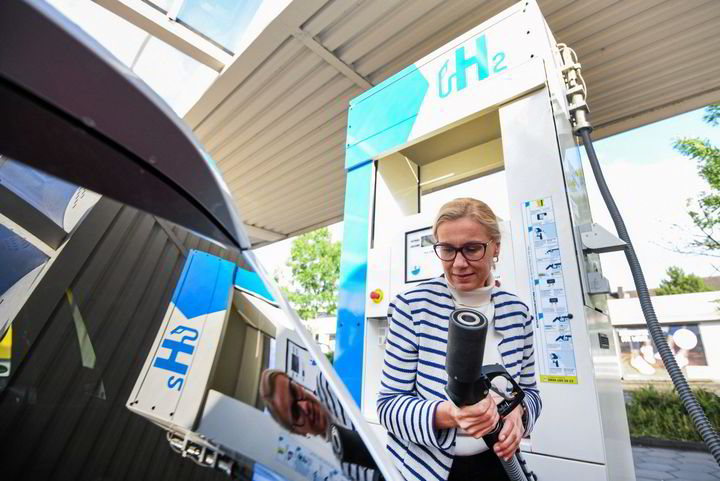EU body calls for more subsidies for hydrogen vehicles to help them compete against battery EVs

The EU should implement long-term subsidies or tax incentives to offset the higher cost of running hydrogen-powered vehicles compared to battery electric vehicles (BEVs), according to a new report from the European Commission’s Joint Research Centre (JRC).
After pointing out that fuel-cell electric vehicles (FCEVs) and buses (FCEBs) “face competition from battery electric alternatives, which benefit from lower operational costs and advancements in technology”, the 110-page document calls for “enhanced financial support” in order to “continue fostering the growth of hydrogen mobility in Europe”.
Specifically, the report — entitled Historical Analysts of Clean Hydrogen JU Fuel Cell Electric Vehicles, Buses and Refuelling Infrastructure Projects — calls for the implementation of “long-term financial mechanisms, such as subsidies or tax incentives specific to hydrogen mobility, to offset the higher operational costs and make FCEVs and FCEBs more competitive”.
The paper explains that since 2010, the Clean Hydrogen Joint Undertaking (JU) and its predecessors (see panel below) have disbursed €116m ($126.5m) of EU funding to FCEV demonstration projects, and a further €126m for FCEBs.
The call for more EU funding from the JRC — which “provides independent, evidence-based knowledge and science, supporting EU policies to positively impact society” — is “misguided”, according to Jan Rosenow, director of European programmes at the independent advisory body Regulatory Assistance Project.
“Public subsidies for clean energy technologies are usually offered to make them cost competitive with fossil fuel technologies,” he tells Hydrogen Insight.
Article continues below the advert
“Thanks to innovation electric vehicles are now cost-competitive with ICE [internal combustion engine] cars from a total-cost-of-ownership perspective and by far the most efficient route to decarbonisation of motorised road transport.
“Hydrogen cars are significantly more expensive than electric vehicles when taking the high costs of refuelling into account. The suggestion that public subsidies should be offered to create cost parity between hydrogen vehicles and electric vehicles is misguided and would be a misallocation of scarce public funds better spent where they are needed.”
Last year, the EU approved a new regulation that requires member states to install hydrogen refuelling stations of heavy-duty and light vehicles every 200km along the core routes of the planned Trans-European Transport Network, and in every “urban node” — an EU term for 424 major cities in the bloc with ports, airports and rail terminals — by 2030.
According to previously published Hydrogen Insight calculations, only 644 new fuel-cell vehicles were registered in the EU in 2023.
The €242m disbursed over the years by the Clean Hydrogen JU has led to the deployment of more than 1,300 FCEVs and more than 400 FCEBs, the JRC report states.
“These initiatives have not only demonstrated the operational advantages and technological readiness of hydrogen-powered transport but have also established a foundation for the first pan-European hydrogen refuelling network,” it says.
“The FCEV projects have shown promise in high-mileage applications, such as taxi fleets, and have spurred interest from various partners in scaling up their fleets.
“Similarly, the success of FCEB deployment has been marked by the growing involvement of regions and an increase in private contributions, highlighting the technology’s viability for public transport systems.”
The general consensus among independent experts is that hydrogen cars will always struggle to compete against BEVs, which are inherently cheaper to manufacture and operate than FCEVs, while the prospects are brighter for H2-powered long-distance heavy vehicles such as trucks and coaches — where the longer charging times for batteries may be too inconvenient for operators.
But this may change as technology improves, with solid-state batteries widely expected to be able to double the ranges of today’s BEVs — and reach full charge from empty in just 15 minutes or less — by the end of this decade.
The Clean Hydrogen Joint Undertaking is the legal name of the Clean Hydrogen Partnership, a public-private partnership supporting research and innovation in hydrogen technologies in Europe that is funded by €1bn from the EU for the 2021-27 period and “at least the equivalent amount of private investment“.
One of its prime responsibilities is to allocate EU funding to hydrogen projects, with a wider aim to “strengthen and integrate EU scientific capacity in order to accelerate the development and improvement of advanced clean hydrogen applications”.
Its three members are the EU (represented by the European Commission); industry body Hydrogen Europe, and its research arm, Hydrogen Europe Research.
Until November 2021 it was known as the Fuel Cells and Hydrogen Joint Undertaking.
FACTBOX





